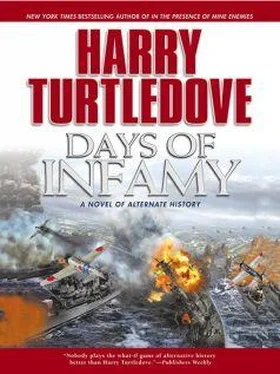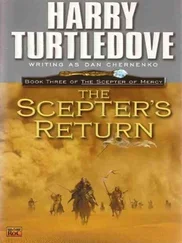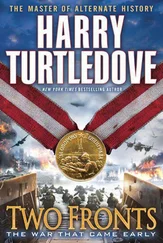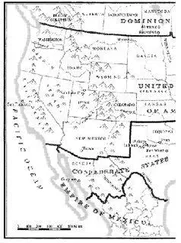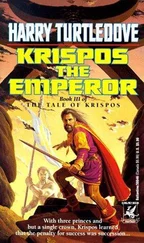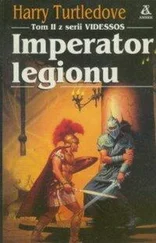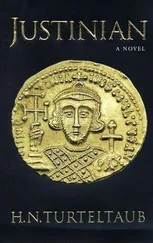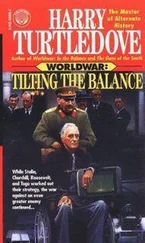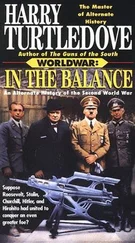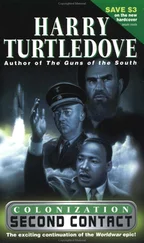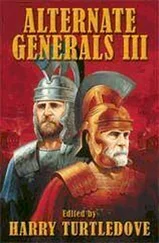Then all thoughts of Kauai, all thoughts of beauty, vanished from his head. There south of the island were ships, their white wakes very visible as they steamed towards Oahu at full speed. Shindo’s heart thuttered with excitement. Now-was the U.S. carrier with them? Yes, that had to be it, there at the heart of the flotilla. The escorting ships-were those battleships, or only cruisers?
He couldn’t tell. He didn’t care, or not much. The carrier counted for more than all the others put together. He radioed its position to his own fleet and to the torpedo bombers that already had to be on the way.
Then he spoke to the pilots he led: “The carrier is your first priority. Attack it at all costs. Only after it is destroyed will you worry about any other ships. Banzai for the Emperor!”
Answering Banzai! s dinned in his earphones. The American ships swelled as he drew closer to them. Flame and smoke burst from the guns of the forward vessels. They’d spotted him, then. Black puffs of smoke dotted the sky ahead. They hadn’t quite found the range. But they would. They would.
“Enemy fighters ahead!” a Zero pilot yelled.
Shindo swore, but only mildly. Of course the American carrier would have a combat air patrol overhead. Zeros orbited the Japanese task force, too-just in case. “Our job is to keep those fighters off our dive bombers,” he radioed to his comrades. “We are expendable. They are not. Let’s go.” He didn’t shout Banzai! again. He was not a showy man.
The Zero’s engine roared as he brought it up to full combat power. He and his fellow fighter pilots left the D3N1s behind as if they were nailed to the sky. There were the Wildcats, boring in on them. He’d already seen the American Navy fliers had courage and to spare.
What they didn’t have was enough in the way of airplanes under them. The Zeros slashed into the enemy planes. One Wildcat after another tumbled toward the Pacific. A Zero fell, too, and then another. The Japanese fighters were lighter and faster and more maneuverable than the Americans, but the Wildcats could take more punishment and keep flying.
There-Shindo turned quicker and harder than any Wildcat could hope to do. His thumb came down on the firing button. The twin 20mm cannon in his wings roared. A tracer round scored a line of what Japanese pilots called ice candy across the sky. Shells blew holes in the Wildcat just behind the cockpit. No plane could survive punishment like that. Spinning wildly, flames pouring from it, the American fighter went down.
Where were the dive bombers? In the fight to keep the Wildcats off them, Shindo had lost track. Then the glint of sun off a cockpit let him spy them. They’d gone into their attack run, stooping on the frantically zigzagging carrier like so many falcons.
In these cerulean seas, the American Navy’s camouflage scheme-dark gray below and light gray above-left something to be desired. It was better suited to gloomier climes farther north. Even from his height, Shindo could make out the planes on the flight deck. Whether the carrier was going to fly them to Oahu or launch a strike against his task force, he didn’t know. Too late now, either way.
Antiaircraft fire snarled up at the diving Aichis. One of them was hit, caught fire, and spiraled into the Pacific. Its bomb went off when it struck, sending up a white geyser of water. But the rest of the dive bombers pressed on fearlessly. They released their bombs one after another and pulled up and away.
“ Banzai! ” Shindo shouted when the first bombs exploded. But they were near misses, one astern, the other to port. The carrier kept dodging, staggering across the sea like a drunk. It did not save her, though. The next three bombs were hits: one near the stern, one on the island, and one not far from the bow. The bursts of flame and great clouds of black smoke showed him the difference between what he’d thought a hit looked like and the real thing.
The hit near the stern, among the airplanes loaded with fuel and torpedoes and bombs, was the one that devastated the carrier. Secondary explosions followed almost at once as the munitions, bathed in fire, went off on their own. Engines damaged, the stricken ship slowed to a crawl. Brave men crewed her, though. The antiaircraft guns that hadn’t been knocked out kept firing at the Japanese planes.
Seeing their comrades’ success, the last three dive bombers pulled up without dropping their bombs. “What are you doing?” Shindo called to them.
“Sir, the carrier is dead in the water,” one of those pilots replied. “We request permission to attack a battleship instead.”
“I think they’re cruisers,” Shindo said. “But even if they are battleships, the carrier is the primary target.” He looked down at it. The Aichi pilot was right; it could not move at all. Still, the Americans were supposed to be very clever, very skillful, at damage control. Shindo made up his mind. “Two of you will strike the carrier again. The third may use his bomb against a cruiser. Do you understand me? All three of you-speak up!”
“Aye aye, sir!” they chorused.
“Obey, then.” Shindo radioed the rest of the D3A1s: “Go back to the ships. If you pass the torpedo bombers coming this way, give them a course.”
The three bomb-laden Aichis climbed back up into the sky, then dove once more. As Shindo had commanded, two of them attacked the carrier. One missed even though the target lay dead in the water. The other bomb, though, struck square amidships. Shindo thought afterwards that that one might have been enough to sink her all by itself. She began to list to starboard. The list quickly grew. Whatever men remained aboard her could do nothing to stop it.
Shindo was so intent on watching her that the fire and smoke suddenly spurting from a cruiser’s-or was it a battleship’s? — superstructure took him by surprise. “ Banzai! ” an excited young pilot shouted in his earphones. “That is a very solid hit!”
“Yes, it is,” Shindo agreed. He ordered the remaining D3A1s back to the carriers, and all the Zeros except his own. If he spotted the torpedo bombers, he could guide them down to the American ships. He throttled back. His plane had more endurance than the dive bombers, especially when he wasn’t going all out in combat. He could afford to loiter here for a while. And he wanted to watch that carrier sink.
She went to the bottom about twenty minutes later. A few boats and rafts bobbed in the water. He supposed individual men were floating and swimming, but he was too high to spot them. Destroyers and cruisers, including the damaged one, gathered to pick up survivors.
Then the ships scattered. They couldn’t possibly have finished picking up all the men from the carrier, but they abandoned them and started throwing up flak. Saburo Shindo spotted the torpedo bombers a couple of minutes later. How had the Americans known about them so soon? Had a cruiser launched a scout? If so, wouldn’t he have seen the slow, clumsy plane catapulted off its ship and shot it down? But if not, how had they done it? Did they have detection gear the Empire of Japan lacked?
That was a question for later. Now Shindo dove on a cruiser and strafed the deck, doing everything he could to distract it from the oncoming Nakajimas. Tracers sizzled all around him. He counted himself lucky that he wasn’t hit. If he had been, he’d intended to try to fly his plane into one of the U.S. ships.
Lieutenant Fusata Iida had tried that sort of thing at Kaneohe. He’d said before the attack began that he would do his best to strike an enemy target if he was shot down. He had been hit, and he’d aimed his Zero at a hangar housing flying boats. He hadn’t been able to hit it, but he’d made the effort. His spirit deserved praise.
Читать дальше
